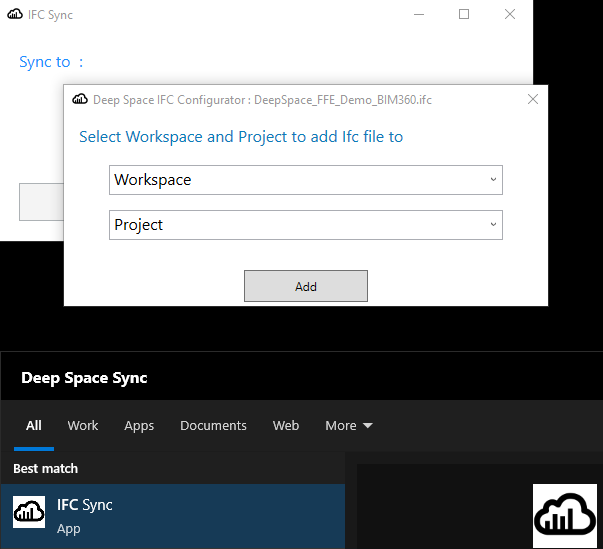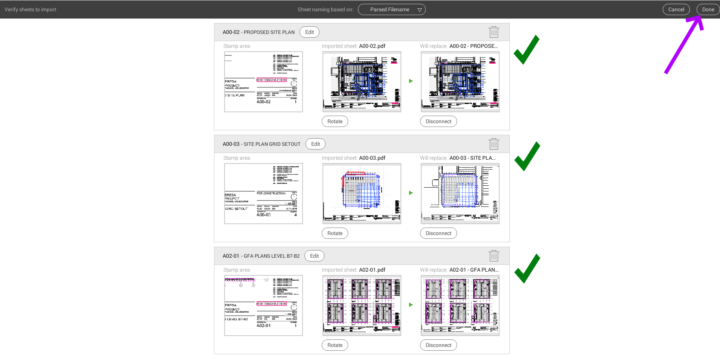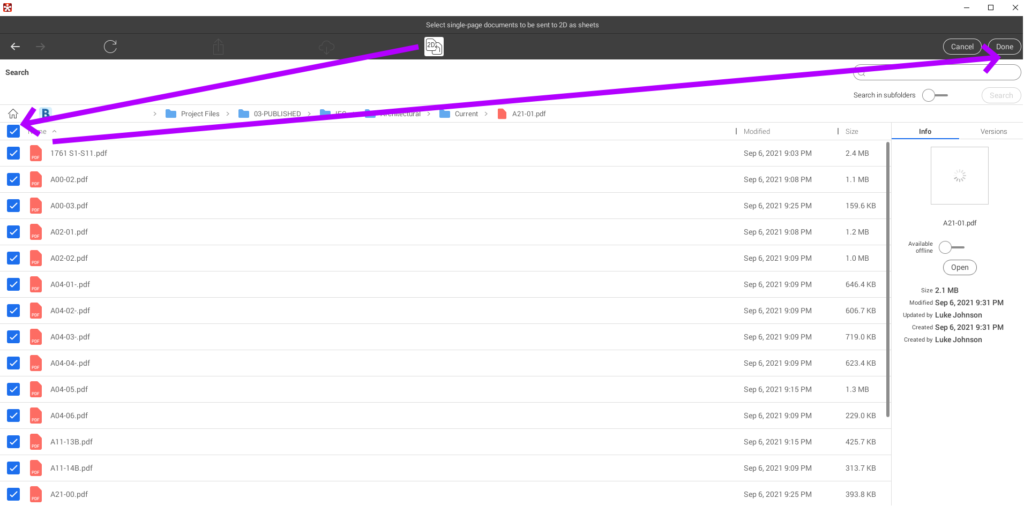What really is the Deep Space Construction Intelligence Platform?? For the past 5 years or so I have been diving deep into Construction data and automation, and along with Michael Clothier we used our decades of BIM and VDC experience to build Deep Space. Check out this video to find out what Deep Space actually is… and let us know what you think in the comments!
Tag: Deep Space
Around 9 months ago I decided to step back from the majority of my consulting work and focus on Deep Space, a digital construction project intelligence platform built by myself and Michael Clothier. After a lot of learning, pitching, refining, and due diligence, we were extremely pleased to reach a milestone last week. We were able to finally share with the world that Deep Space has been officially funded by VentureOn Partners, a forward-thinking ConTech + PropTech SaaS investment company in Australia!
Here is part of the press release:
VentureOn Partners Pty Ltd (VentureOn), a leading venture capital firm headquartered in Brisbane, Australia, is thrilled to announce a significant investment in Deep Space, an innovative construction technology (contech) company. This strategic investment marks a pivotal moment in the contech journey.
Luke Johnson, Co-Founder and CEO of Deep Space, expressed his enthusiasm about the partnership: “We are delighted to welcome VentureOn as a strategic investor,” said Johnson. “Their commitment and operational collaboration will undoubtedly propel Deep Space to new heights in the construction technology landscape.”
“VentureOn’s investment is a testament to the value our solutions bring to major construction projects globally,” said Michael Clothier, Co-Founder and COO of Deep Space. “This partnership aligns perfectly with our vision of expanding our reach and impact.”
Today, Deep Space is trusted by industry professionals globally and has proven instrumental in enhancing the efficiency of major construction projects. Deep Space’s unique solutions have already demonstrated their value in high-profile projects such as the Hong Kong Airport and Cross River Rail, significantly improving their efficiency and data handling capabilities. Their suite of services, including data acquisition add-ins, secure cloud storage, and pioneering Core Thread Technology, truly sets them apart in the market.

VentureOn’s investment comes with a clear vision of working closely with Deep Space to expand its operations both domestically and scale internationally. This partnership is set to drive growth and development, with a focus on scaling the company and achieving a Series A investment for continued global expansion.
“This investment reaffirms VentureOn’s vision of nurturing and scaling local SaaS companies to achieve international success,” said Sean Diljore, Co-Founder and General Partner at VentureOn. “Our hands-on approach to growth and strategy makes us a valuable partner for companies like Deep Space.”
VentureOn’s commitment to the construction tech and property tech domains is evident through this strategic investment, which comes shortly after the acquisition of Story Bridge Ventures and PropTech BNE earlier in October. The company believes in the transformative potential of these domains and aims to support innovations that enhance the construction and property industry.
This new operational collaboration forms a vital foundation for the partnership with Deep Space.
“We are enthusiastic about the vast potential of Deep Space,” said Ricky Sevta, Co-Founder and General Partner at VentureOn. “Through VentureOn’s investment and operational support, our goal is to expedite Deep Space’s growth and broaden its global presence, delivering innovative solutions to the construction domain.”
Read the rest of the press release here.
Follow Deep Space here.
Follow VentureOn Partners here.
Yes, I’m going to do this. I’m going to write another post about a widely used term and try to untangle reality from the fiction. Let’s talk about the term “AI”… Mr Gates wrote a compelling article recently about AI Agents specifically, and even Mr Clippy got a slightly dishonourable mention. But hold on to your chatbots hats, because we are going to go right back to basics…
First, let’s define some terms related to AI.
Intelligence
The faculty of understanding; intellect.
Artificial
made or constructed by human skill, especially in imitation of, or as a substitute for, something which is made or occurs naturally;
Now, we might assume that Artificial Intelligence means something man-made that has the faculty of understanding, right? Right?
As a verb, to understand means to know or realise the meaning of words, a language, what somebody says, etc.
Now, let’s compare this with a common definition of artificial intelligence…
the study and development of computer systems that can copy intelligent human behaviour.
Or, on Wikipedia:
Artificial intelligence (AI) is the intelligence of machines or software, as opposed to the intelligence of humans or animals.
And finally, AGI:
An artificial general intelligence (AGI) is a hypothetical type of intelligent agent. If realised, an AGI could learn to accomplish any intellectual task that human beings or animals can perform.
Now, you may ask, “what’s with all the definitions?” My personal feeling is that the perception of commonly available AI tech progress is largely overestimated and misunderstood, and that the ultimate aspirations of AGI are some distance away. So what’s with all the AI hype?
A few things definitely changed in the past couple of years. Tools claiming to be AI became widespread, and the technology started to be viewed as useful and cool. Let’s start with OpenAI and ChatGPT. It took the world by storm! It has a massive budget and huge backing. But what is it really?
ChatGPT, PaLM / Bard, and LLaMa are all Large Learning Models. They consume massive amounts of data, build a kind of neural network, and then you can converse with them. But guess what? They don’t have the human faculty of understanding. They are effectively guessing what the next word should be based on context and a massive set of data and processing power. Almost all Copilot-like technology works on this basis, except you can introduce your own contextual data into the model. LLMs must be trained on data that was ultimately produced by humans when in its “most raw form.”
Is it cool? Yes. Is it useful? Sure. Can it save you time? Yep. Is it anywhere near human intelligence? Of course not. You can’t measure a faculty of true understanding based on outputs and interactions. Understanding happens on the inside. I don’t believe I’m saying anything too controversial, but I do believe we should occasionally ask the question “what level of AI tech do we really have right now?”
What about image generation, specifically text-to-image models like DALL-E 3, Imagen, and Midjourney? These actually use some variation of an LLM – the input text is converted and fed to a generative image model. That model has been trained on massive amounts of text and image data scraped from all over the place. It seems creative but isn’t it really a tool that adapts and morphs known images into some new variation? Again, they must be trained on data that was ultimately produced by humans when in its “most raw form.”
Perhaps I’m oversimplifying, but does the current global state of AI tech approach anywhere near the creativity and original ingenuity of a human? Not even close. They are powerful tools that are transformative and disruptive. But they are really Super Guess Makers. They produce contextual linear things that ultimately are a version of “the system knows billions of types of representational data, and it can try to build you something like what it already knows.”
I want to introduce you to a new term. At Deep Space, we have a proprietary data framework that we call Core Thread Technology. Part of that technology framework is Embodied Intelligence. Let’s define it..
Embodied Intelligence is found when a computerised system has inbuilt comprehension of data classification, relationships, workflows, and qualitative measures. This inbuilt comprehension is encoded into the system by humans based on a depth of real world experiences, probably over decades.
Does Deep Space have AGI right now? No.
But Deep Space does have Embodied Intelligence.
We have already established that the majority of cool and powerful AI tech currently available has been trained on raw data originally and usually attributed to human agents. I believe the AI term itself is really too generous for the majority of the currently available tech. But Embodied Intelligence is a practical term that embraces the fact that there are experienced industry leaders who can legitimately train a system in specific ways to maximise productivity.
That is what we are doing for Digital Design and Construction at Deep Space right now.
I’m very excited to report that the Deep Space platform continues to rapidly evolve, bringing exciting updates that empower civil and infrastructure projects. In a recent release, Deep Space introduced new and enhanced existing synchronization plugins and tools, revolutionizing data acquisition, analysis, and compliance checking. This blog post delves into the key new features of the Deep Space Sync add-in, focusing on its IFC integration and LOI (Level of Information) Report capabilities. Jump straight to the video here.
Simplifying Data Acquisition and Storage
Deep Space now offers a user-friendly IFC Sync plugin, enabling users to effortlessly load data from IFC (Industry Foundation Classes) files into the platform. By selecting the desired IFC file, workspace, and project, users can seamlessly upload the information to Deep Space. This streamlined process ensures that different data and model formats, such as IFC and Revit files, are easily accessible and integrated within the platform.
Exploring Data and Parameter Analysis
Once the data is uploaded, users can navigate to the Deep Space Explorer platform to explore various applications. The Data app provides a comprehensive overview of the acquired information from the IFC file. Users can visualize the data, including the element count, parameter summaries, and individual parameter values. By clicking on specific objects, users can access detailed parameter data, facilitating a deeper understanding of the model.
Efficient Compliance Checking with LOI Reports
Deep Space’s LOI Report app is a powerful tool for compliance checking, particularly for projects adhering to government requirements like the Transport for NSW Digital Engineering Standards. The app automates the verification process, comparing the required parameters against the actual data within the IFC and Revit-based models. By unifying both types of data, Deep Space provides a single platform for comprehensive checking, streamlining the compliance process.
Advanced Analysis and Customization
The LOI Report offers an array of functionalities for in-depth analysis. Users can check the existence of parameters and validate the presence of data within those fields. Deep Space also supports the verification of shared parameter GUIDs and duplicates, ensuring the uniqueness of asset IDs. Through drill-down capabilities, users can access specific files, view available information, and explore the requirements tied to each parameter set.
Configuration and Automation
Deep Space provides a robust configuration engine (we call it DS Command), allowing users to modify templates, load parameter standards, and create a master parameter set for consistent use across projects. Additionally, the platform offers scheduling capabilities, enabling users to automate the export of models at predefined times. By simplifying configuration and scheduling tasks, Deep Space optimizes efficiency and reduces manual effort.
Conclusion
The latest Deep Space release showcases its commitment to overcoming industry challenges related to diverse data formats, data acquisition, and analysis. With the IFC Sync add-in and updated LOI Report app, Deep Space provides a comprehensive solution for integrating IFC files, performing compliance checks, and ensuring predictable outcomes. By leveraging Deep Space’s powerful features, Digital Engineers and Design and Construction teams can accelerate project delivery, reduce risks, and enhance overall quality.
First, let’s manage some expectations – Aconex is generally viewed as a closed platform. They seem to deliberately resist platform-level integration with other tools like BIM 360 and Revizto. However, you can achieve the promise in the title of this post – with a bit of work!
The basic steps are:
- Setup a sync between the Aconex Doc Register and Autodesk Docs (BIM 360 Document Management), using the Aconex PIF and Autodesk APIs
- Connect the BIM 360 project to the Revizto project and connect your BIM 360 ‘official Aconex’ PDFs to Revizto 2D Sheets.
Step 1 – Aconex Document Register sync with BIM 360 Document Management
Aconex provides a PIF (Project Integration Framework). This essentially acts as an API, and clients are able to build integrations between Aconex and other tools using their own budget.
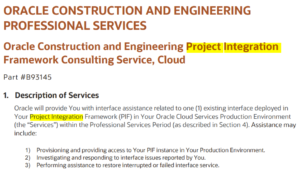
As part of my strategic consultancy work as a Director at Virtual Built Technology, I have assisted clients in setting up the Aconex to BIM 360 sync. This will require considerable time, effort, $$ and planning. Although the scope is basically the same for every Aconex client that wants this, it seems individual Aconex clients will be charged significantly for this development to occur and operate on their ‘own’ PIF.
Once complete, you will begin to see PDFs arriving in Autodesk Docs from Aconex on a daily / nightly basis. Depending on how you have briefed the Aconex development consultants, you may end up with some interesting PDF file naming in the BIM 360 environment – so how can we deal with that?
Step 2a – BIM 360 Preparation Script for Merging Filenames to a single Folder
Let’s say you have your Aconex-to-BIM360 sync running, and you have PDFs arriving in 360 into “Discipline” folders like Architectural, Structural and so on. Not bad! But what if your PDFs are named like this:
-
SheetNumberX_Rev_1.pdf
-
SheetNumberX_Rev_2.pdf
-
SheetNumberY_Rev_1.pdf
-
etc
When thinking about downstream applications like Revizto, this is really sub-optimal. Why? Because a Revizto 2D sheet will want to connect directly to a SINGLE BIM 360 PDF document with Versions – not to a mangled set of ‘revision suffixed’ pdfs like the above. So we need to clean this up! And it needs to be repeatable and automated…
For this, I have created a PowerShell script. Here is a description of the logic in the script:
- it takes a list of BIM 360 Docs folder paths (the local folder path from Windows Explorer address bar), these are ‘monitored folders’
- those folders need to be ‘synced’ prior to the script running (I’m still looking for a way to call the Autodesk Desktop Connector sync from a Powershell script, for now you have to right-click in Windows Explorer first)
- it will process the folder list and:
- create a subdirectory called “Current”
- create a logfile in that subdirectory called deepSpaceSync.log
- split the filenames at the _REV_ part
- process each available Revision number individually in a loop (to ensure Aconex revisions are stored sequentially into BIM 360 versions)
- check if the file was already copied – and skip it (using existence of that filename in the log folder)
- or, copy the file to the “Current” subfolder
- Sleep 5 minutes between each loop to allow Autodesk Desktop Connector sync to catch up.
So this script essentially merges the messy “REV” filenames into a nice clean SheetNumber.pdf filename structure AND actually creates BIM 360 file versions in the cloud (due to the sleep functionality).
We have released this script as a publicly available Deep Space Automation at this link.
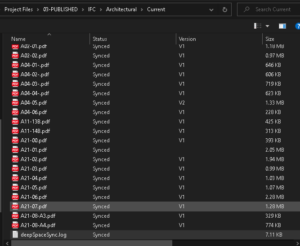
Step 2b – Revizto 2D Sheet to BIM 360 PDF Connection
Now that we have a nicely named, version-rich PDF on BIM 360 Docs, its time to connect that up to Revizto.
Firstly – you should always publish 2D sheets from Revit BEFORE setting up the Docs connection if possible, as this is the only way to get the automated viewport overlays (Note – you can export with “Sheet coordinates only” option in Revizto Sheet Exporter from Revit).
Secondly – you then
- open Revizto
- ensure you have connected Docs to the right BIM 360 hub in Revizto
- browse to the “Current” folder for a specific disciplines PDFs
- click “Send to 2D”
- select all and Done
- then review that the correct sheets are going to be replaced and connected to the BIM360 PDF
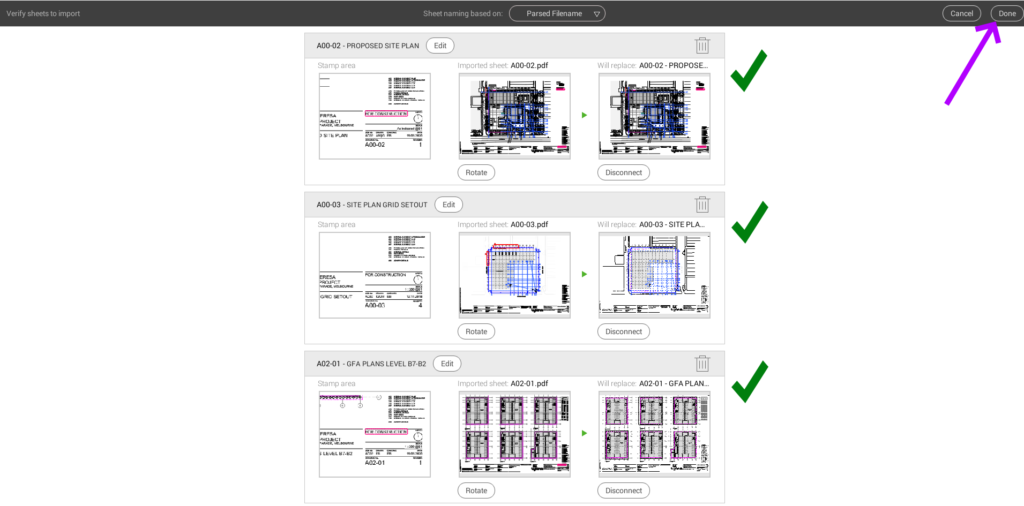
Final steps
Once your PDFs are flowing well between platforms, you may want to automate further. For example, the PowerShell script provided above could be set to run as a Windows Task. You would want it to run as soon as possible after the Aconex scheduled sync to BIM 360. As always, you should monitor your inputs and outputs for any problems or gremlins.
Done! You now have official documents from Aconex flowing regularly into Revizto via BIM 360. This means your site teams using Revizto on the iPad can now be accessing the official For Construction PDF Drawings (synced from Aconex Doc Register) while in the Field!
Over the past few years we have been building and refining a data platform for AEC and Infrastructure projects – we call it Deep Space. It has allowed us to manage huge projects, develop powerful analytics, and increase productivity and efficiency with automations.
We just released a brand new version of our Revit addin, check out the first demonstration video here:
Feel free to check out the website at https://www.deepspacesync.com/
We hope to meet you in Deep Space soon!

